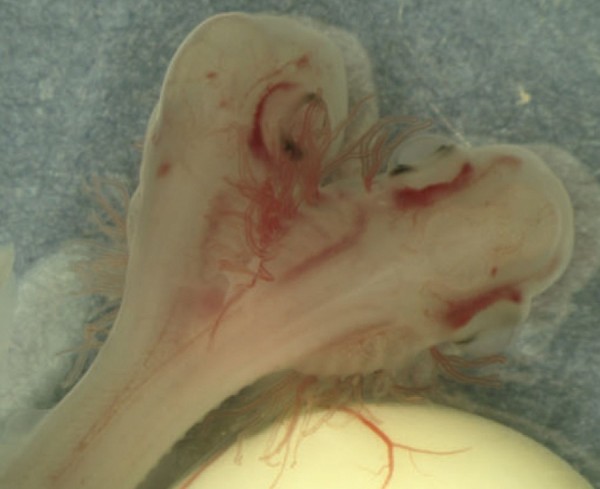By Ana Verayo, | November 08, 2016

The embryo of the two-headed Atlantic sawtail catshark (Galeus atlanticus). (Journal of Fish Biology)
Sharks are considered as terrifying creatures of the deep, what if there are two-headed sharks lurking in the waters? These mutant sharks may sound something from a movie, but scientists say that this is a rare case and can hardly survive into adulthood.
In a new study, researchers from the University of Malaga in Spain accidentally came across a two-headed shark specimen when they were studying the nearly threatened species of Atlantic sawtail catshark (Galeus atlanticus) and its cardiovascular system during its embryo stage. Scientists were mesmerized by a translucent egg that possessed a two-headed catshark inside.
Like Us on Facebook
Scientists were able to examine this two-headed shark specimen for the first time in egg laying shark. The team said that each shark head had two eyes, a mouth, and a brain, including a notochord or a spinal cord and five gills on each side. There are also two hearts and two oesophaguses, two stomachs including two livers.
According to Michelle Heupel from the Australian Institute of Marine Science, this two-headed shark can survive after birth, but its life would be very brief. She added that it is unclear whether two heads can prohibit its ability to swim and capture prey as joined internal organs may or may not function properly.
Heupel notes that there are no agents that can cause shark embryos to develop into mutants and cause any defects, and this is most likely caused by genetics.
According to the Director of the Florida Museum of Natural History, George Burgess, two-headed sharks can be seen occasionally since it is also an anomaly caused by a genetic misfire. He added that there are different kinds of these genetic misfires, but most of them do not survive outside the womb.
In this new study, out of these 797 healthy catshark embryos, one of them was this mutant two-headed shark. Researchers euthanized the embryo in formaldehyde and alcohol to preserve it for future research.
This new study was published in the Journal of Fish Biology.
-
Use of Coronavirus Pandemic Drones Raises Privacy Concerns: Drones Spread Fear, Local Officials Say

-
Coronavirus Hampers The Delivery Of Lockheed Martin F-35 Stealth Fighters For 2020

-
Instagram Speeds Up Plans to Add Account Memorialization Feature Due to COVID-19 Deaths

-
NASA: Perseverance Plans to Bring 'Mars Rock' to Earth in 2031

-
600 Dead And 3,000 In The Hospital as Iranians Believed Drinking High-Concentrations of Alcohol Can Cure The Coronavirus

-
600 Dead And 3,000 In The Hospital as Iranians Believed Drinking High-Concentrations of Alcohol Can Cure The Coronavirus

-
COVID-19: Doctors, Nurses Use Virtual Reality to Learn New Skills in Treating Coronavirus Patients








